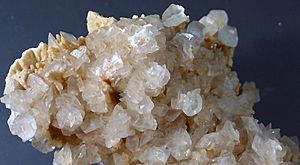Dolomite facts for kids
Dolomite is both a type of mineral and a type of rock. It's a special kind of rock called a sedimentary rock. Both the mineral and the rock are made of calcium and magnesium carbonate. You can find dolomite in beautiful crystals.
When we talk about the rock, it's also called 'dolostone'. It's mostly made up of the mineral dolomite. Sometimes, limestone can change and get some dolomite in it. This is called 'dolomitic limestone'. The name "dolomite" first came from the Dolomite Alps in northern Italy, where it was described in 1791.
Contents
History of Dolomite
The mineral dolomite was likely first mentioned by Carl Linnaeus in 1768. Later, in 1791, a French naturalist and geologist named Déodat Gratet de Dolomieu (1750–1801) described it as a rock. He first saw it in old buildings in Rome. Then he found samples in the mountains of northern Italy, which are now called the Dolomite Alps. In March 1792, Nicolas-Théodore de Saussure officially named the mineral "dolomite" after Dolomieu.
What Are Dolomite's Properties?
The mineral dolomite forms crystals that belong to a group called the trigonal-rhombohedral system. These crystals can be white, tan, gray, or even pink.
Dolomite is a "double carbonate." This means it has a special structure where calcium and magnesium atoms are arranged in an alternating pattern. Unlike calcite, dolomite doesn't fizz quickly when you put a weak acid on it. It also doesn't dissolve very fast. It's common for dolomite crystals to show twinning, where two crystals grow together in a mirrored way.
Sometimes, other elements can replace small amounts of magnesium in dolomite.
- If there's a little iron, the crystals might look yellow to brown.
- If there's more manganese (up to about three percent), the crystals can have a pretty rosy pink color.
- Elements like lead, zinc, and cobalt can also take the place of magnesium.
Dolomite is related to another mineral called huntite.
Because slightly acidic water can dissolve dolomite over time, areas with a lot of dolomite are important. They can hold water underground, acting as aquifers. This dissolving process also helps create interesting karst landscapes, which have features like caves and sinkholes.
How Does Dolomite Form?
Today, we've found dolomite forming in special conditions. This happens in very salty lagoons along the coast of Rio de Janeiro, Brazil. These areas have very little oxygen, which helps dolomite form. Scientists used to think that tiny organisms called sulfate-reducing bacteria were always needed for dolomite to form. However, we now know that dolomite can also form at low temperatures in places with a lot of organic material and tiny living cells. This happens because magnesium sticks to certain parts of the organic matter.
Even though there are huge amounts of dolomite in old rocks, it's quite rare to see it forming in nature today. In 1999, scientists were able to create dolomite in labs for the first time at low temperatures. They found that a less stable mineral forms first. Then, through cycles of dissolving and re-forming, it slowly changes into the more stable dolomite.
There's even a strange example of dolomite forming inside the urinary bladder of a Dalmatian dog! This might have happened because of an illness or infection.
Uses of Dolomite
Dolomite is used in many ways:
- It's a popular ornamental stone for buildings and decorations.
- It's mixed into concrete as an aggregate, which means it's a material added to make the concrete stronger.
- It's a source of magnesium oxide, which is used in many industrial processes.
- It's important in the Pidgeon process to make magnesium metal.
- Dolomite rock can hold petroleum and natural gas, making it an important oil and gas reservoir rock.
- It's also the host rock for large deposits of valuable metals like lead, zinc, and copper. These are called Mississippi Valley-Type (MVT) ore deposits.
- When calcite limestone is hard to find or too expensive, dolomite is sometimes used as a flux in the process of smelting iron and steel. A flux helps remove impurities.
- Large amounts of processed dolomite are used to make float glass, which is the flat glass used in windows.
In horticulture (gardening), dolomite and dolomitic limestone are added to soils and potting mixes. They help keep the soil's pH balanced and provide magnesium, which plants need to grow. This is common in home and container gardening.
Dolomite is also used in marine (saltwater) aquariums. It helps keep the water's pH stable, which is important for the fish and other sea creatures.
Finally, dolomite that has been heated (calcined dolomite) can be used as a catalyst. A catalyst helps speed up chemical reactions. In this case, it helps break down tar when biomass (plant material) is turned into gas at high temperatures.



